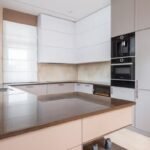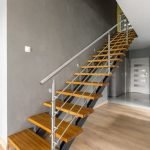What does industrial mean in home decor? Industrial design in home decor has been gaining popularity in recent years, with its unique blend of modern and vintage elements.
In this article, we will explore the history of industrial design in home decor, the characteristics that define it, the materials and finishes commonly used, as well as how to incorporate industrial elements into your own home. Whether you’re a fan of the rugged look or simply curious about this trend, read on to discover how you can embrace the industrial style in your home.
Industrial design in home decor has roots that date back to the 20th century, with its origins in converted warehouse apartments and factory lofts. The look is characterized by raw and unfinished materials, exposed architectural elements, and an overall edgy aesthetic. From there, it has evolved into a versatile style that can be adapted to fit any space, from urban lofts to suburban homes.
One of the key characteristics of industrial home decor is its emphasis on functionality and minimalism. Clean lines and simple forms are often favored, allowing the focus to remain on the architectural features and utilitarian aspects of the space.
Additionally, neutral color palettes are commonly used to create a sense of cohesion and simplicity within an industrial interior. With its rich history and distinct characteristics, industrial design offers a unique approach to decorating that appeals to those looking for a modern yet rugged look for their homes.
History of Industrial Design in Home Decor
Industrial design in home decor has a rich and fascinating history that dates back to the late 19th century. During this time, the Industrial Revolution was in full swing, transforming the way goods were manufactured and revolutionizing design aesthetics. This era marked a shift from handcrafted items to mass-produced goods, leading to the rise of industrial design in various aspects of life, including home decor.
The Rise of Industrial Design
The Industrial Revolution brought about significant changes in manufacturing processes, resulting in the availability of affordable materials such as steel, iron, and concrete. These materials became prominent features in home decor, reflecting a raw and utilitarian aesthetic that celebrated functionality over ornamentation.
Influence on Home Decor
Industrial design found its way into home decor as people began to embrace the simplicity and honesty of industrial materials. Exposed brick walls, metal piping, and salvaged wood became popular elements in interior spaces, reflecting a departure from traditional decorative styles. The focus on practicality and durability also contributed to the widespread adoption of industrial design in homes, as people sought to create functional living spaces that reflected the fast-paced nature of modern life.
As industrial design continued to evolve over the years, it has remained a powerful influence in home decor, with many homeowners embracing its raw aesthetic and unconventional charm. Understanding the history of industrial design provides insight into its enduring appeal and offers inspiration for incorporating industrial elements into modern interiors.
Characteristics of Industrial Home Decor
Industrial home decor is a unique and popular style that brings raw, edgy, and unfinished elements into the interior design of a living space. In this section, we will explore the characteristics of industrial home decor and take a closer look at what makes this style so appealing to homeowners and interior designers alike.
One of the key characteristics of industrial home decor is the use of raw and rough materials such as exposed brick, concrete, and reclaimed wood. These materials bring an urban and gritty feel to a space, giving it a sense of authenticity and history. Additionally, industrial home decor often features open and spacious layouts with high ceilings, creating an airy and expansive atmosphere.
Another defining characteristic of industrial home decor is the incorporation of mechanical elements such as pipes, metal fixtures, and vintage machinery. These elements add an element of ruggedness and functionality to the space, evoking a sense of the industrial revolution era. This style also embraces the beauty in imperfections by showcasing visible hardware and weathered surfaces.
Furthermore, industrial home decor often emphasizes an open floor plan that presents minimal barriers between different areas within a room. This layout reflects the utilitarian nature of industrial spaces while allowing for easy flow and movement throughout the home. The overall aesthetic is stripped down to its bare essentials without sacrificing comfort or warmth, creating a balance between form and function.
Industrial Materials and Finishes
Metal is another essential element in industrial home decor, with steel, iron, and aluminum being commonly used materials. These metals are often left untreated or have a weathered finish to enhance their industrial appeal. In addition to raw materials, industrial home decor also incorporates distressed or aged finishes on furniture and fixtures, further adding to the rugged charm of the space.
Incorporating these industrial materials and finishes into your home can be achieved through various means. Whether it’s through architectural elements like exposed beams or by using furniture pieces made from reclaimed wood or metal, there are countless ways to bring an industrial vibe into your living space. Light fixtures with metal details or rusty finishes can also contribute to the overall industrial look and feel of a room.
| Industrial Materials | Industrial Finishes |
|---|---|
| Raw Wood | Rusty Metal |
| Exposed Brick | Aged Patina |
| Metal (Steel, Iron) | Weathered Finish |
With these foundational elements in place, homeowners can achieve an authentic industrial look that showcases a rugged yet refined aesthetic within their personal spaces.
Incorporating Industrial Elements Into Your Home
When it comes to incorporating industrial elements into your home decor, there are several key areas to focus on. Whether you’re looking to completely revamp your space or simply add a few industrial touches, these tips will help you bring the unique and stylish industrial aesthetic into your home.
Here are some ideas for incorporating industrial elements into your home:
1. Industrial Lighting: One of the easiest ways to introduce industrial elements into your home is through lighting. Look for fixtures with exposed bulbs, metal shades, and vintage-inspired designs. Industrial pendant lights, Edison bulbs, and wall sconces can all add a touch of industrial charm to any room.
2. Vintage Furniture: Incorporate vintage industrial furniture pieces into your decor. Look for items like metal and reclaimed wood tables, distressed leather chairs, and vintage lockers or cabinets. These pieces will add character and authenticity to your industrial-inspired space.
3. Exposed Elements: Embrace raw and unfinished elements in your decor such as exposed brick walls, concrete floors or countertops, and ductwork or piping. These features are quintessential to the industrial style and can instantly transform the look and feel of a room.
By incorporating these industrial elements into your home decor, you can create a space that is both stylish and functional, with a nod to the rich history of industrial design. Whether you choose to go all-in with an industrial-inspired theme or simply add a few key pieces, embracing the industrial style in your home is sure to make a lasting impression.
Industrial Furniture and Lighting
The history of industrial design in furniture and lighting can be traced back to the 19th century when factories and warehouse spaces were repurposed into living areas. This led to the introduction of utilitarian furniture and bare-bulb lighting fixtures that became defining characteristics of industrial decor. Today, this style has evolved to incorporate a mix of vintage and modern elements, making it a popular choice for interior design enthusiasts.
Incorporating industrial furniture and lighting into your home can be achieved by selecting pieces that embrace simplicity, functionality, and minimalism. Steel-framed sofas, distressed leather armchairs, and wooden coffee tables are common choices for industrial-inspired living rooms. As for lighting, exposed bulb pendants, metal sconces, and floor lamps with adjustable arms are great options to enhance the industrial aesthetic in any room.
| Characteristics | Description |
|---|---|
| Materials | Raw, unfinished materials such as exposed bricks, steel, and reclaimed wood. |
| Lighting Fixtures | Sleek and simple designs with metal finishes; exposed bulb pendants, metal sconces. |
| Furniture | Utilitarian furniture with a mix of vintage and modern elements; steel-framed sofas, distressed leather armchairs. |
Color Palette for Industrial Home Decor
The color palette plays a significant role in defining the industrial style in home decor. When it comes to industrial design, the color scheme typically revolves around a neutral and muted palette, providing a sense of rawness and simplicity. The colors often seen in industrial home decor include shades of gray, black, brown, and white. These colors are used to create a minimalist and sophisticated ambiance that is characteristic of industrial style.
Neutral Base
The use of neutral colors such as gray and beige as a base for industrial home decor is essential in creating a cohesive and balanced look. These colors serve as a backdrop for the other elements in the space, allowing them to stand out without overpowering the overall aesthetic. Additionally, incorporating natural materials such as exposed brick walls or concrete flooring can further enhance the industrial feel of the space while complementing the neutral color palette.
Accent Colors
Incorporating accent colors into industrial home decor can add depth and visual interest to the space. While maintaining the overall neutral palette, pops of darker hues like deep blues or greens can be added through accessories such as throw pillows, area rugs, or wall art. These accent colors provide contrast and create focal points within the room without deviating from the industrial aesthetic.
Metallic Finishes
Another way to introduce color into industrial home decor is through metallic finishes. Industrial design often incorporates metal elements such as iron, steel, and brass. These materials can be incorporated into furniture pieces, light fixtures, or decorative accents to introduce warmth and depth into the space while adding a touch of color through the metallic sheen.
Industrial Decor DIY Projects
When it comes to industrial home decor, DIY projects are a great way to incorporate this style into your living space while staying within budget. Whether you’re a fan of rustic elements or an urban aesthetic, there are countless DIY projects that can help you achieve the industrial look you desire. Here are some ideas to get you started:
1. Pipe Shelves: One of the most iconic elements of industrial design is the use of pipes as shelving. By using galvanized pipes and reclaimed wood, you can create unique and functional shelves that add an industrial touch to any room in your home.
2. Metal Accents: Adding metal accents to your furniture or decor pieces can instantly give them an industrial feel. Try incorporating metal legs on a coffee table or using metal hardware on your cabinets and drawers for a modern and edgy look.
3. Concrete Planters: Embrace the raw and unfinished look of concrete by creating your own planters. Simply pour concrete into molds of various shapes and sizes, then let them dry before adding your favorite plants for a minimalist and industrial touch.
These DIY projects allow you to customize your home decor while embracing the industrial style. Whether you’re looking to add small touches or completely transform a room, these projects are sure to make a statement in your home.
Conclusion
In conclusion, the industrial style in home decor is a unique and versatile design trend that brings the raw and rugged beauty of industrial spaces into your home. From its origins in the Industrial Revolution to its modern interpretation, industrial decor has continued to evolve and capture the imagination of homeowners and designers alike. The use of unfinished materials, utilitarian furniture, and vintage-inspired elements all contribute to the distinctive charm of industrial home decor.
As we have explored throughout this article, industrial home decor encompasses a wide range of characteristics, from exposed brick walls and metal piping to reclaimed wood and weathered steel. By embracing the industrial style in your home, you can create a space that is both functional and visually compelling. Whether you are drawn to the minimalist appeal of industrial design or appreciate its rustic aesthetic, there are countless ways to incorporate industrial elements into your home.
Incorporating industrial style into your living space allows you to infuse personality and character into your home decor. Whether you opt for vintage factory lighting or DIY projects using salvaged materials, embracing the industrial look offers a way to express individuality and creativity in your interior design.
So, if you are wondering what does industrial mean in home decor, remember that it is about celebrating imperfections, embracing raw materials, and creating an inviting environment that reflects the rich history of industrial design. Whether it’s through furniture selections or small decorative accents, introducing touches of industrial style can inject an edgy yet inviting vibe into any living space.
Frequently Asked Questions
What Is Considered Industrial Decor?
Industrial decor is characterized by a raw, unfinished, and utilitarian aesthetic. It often features materials like exposed brick, concrete, metal piping, and reclaimed wood. The color palette tends to be neutral and muted, with an emphasis on function over form.
What Is Industrial Style in Interior Design?
Industrial style in interior design is a trend that draws inspiration from old factories and industrial spaces. It often incorporates elements like open floor plans, high ceilings, exposed beams, and large windows to create a spacious and airy feel. The use of metal furniture, vintage lighting fixtures, and salvaged architectural elements also contributes to the industrial look.
What Does It Mean if Something Looks Industrial?
When something looks industrial, it typically means that it has a rough or rugged appearance reminiscent of old warehouses or manufacturing facilities. This could include features like distressed or weathered surfaces, exposed mechanical systems, and a focus on simplicity and practicality in design. Overall, an industrial look conveys a sense of urban grit and functionality.

I’m thrilled to be your companion on this exciting journey through the world of home decor and design. With a passion for turning houses into homes and a keen eye for the finer details, I’m here to help you transform your living spaces into beautiful, functional, and meaningful havens.





